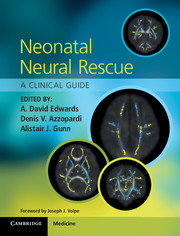Book contents
- Frontmatter
- Contents
- List of contributors
- Foreword
- Section 1 Scientific background
- 1 Neurological outcome after perinatal asphyxia at term
- 2 Molecular mechanisms of neonatal brain injury and neural rescue
- 3 The discovery of hypothermic neural rescue therapy for perinatal hypoxic–ischaemic encephalopathy
- 4 Clinical trials of hypothermic neural rescue
- 5 Economic evaluation of hypothermic neural rescue
- Section 2 Clinical neural rescue
- Section 3 The future
- Index
- References
4 - Clinical trials of hypothermic neural rescue
from Section 1 - Scientific background
Published online by Cambridge University Press: 05 March 2013
- Frontmatter
- Contents
- List of contributors
- Foreword
- Section 1 Scientific background
- 1 Neurological outcome after perinatal asphyxia at term
- 2 Molecular mechanisms of neonatal brain injury and neural rescue
- 3 The discovery of hypothermic neural rescue therapy for perinatal hypoxic–ischaemic encephalopathy
- 4 Clinical trials of hypothermic neural rescue
- 5 Economic evaluation of hypothermic neural rescue
- Section 2 Clinical neural rescue
- Section 3 The future
- Index
- References
Summary
Introduction
Moderate cooling by 3–4°C is the first successful neural rescue therapy for neonatal encephalopathy. Induced moderate cooling has also been shown to protect the brain in adults following cardiac arrest and has shown promise in other forms of cerebral injury. Although there are several historical reports of induced cooling, the implementation of moderate cooling for neural rescue in newborns with hypoxic–ischaemic brain injury is the culmination of a series of research spanning decades that: proved the potential for neural rescue following perinatal asphyxia [1]; consistently showed benefit in appropriate experimental models [2,3]; examined safety and feasibility in preliminary clinical studies [4,5]; confirmed efficacy by synthesis of the results of several well-conducted randomized clinical trials in newborns [6]; and was followed by rapid implementation into clinical practice and ongoing surveillance [7]. This chapter will examine the findings of the clinical trials of neural rescue therapy with moderate cooling in newborns. The results of these studies led to recommendations by expert groups, specialist advisory committees and regulatory authorities for the rapid implementation into clinical practice of treatment with cooling for neonatal encephalopathy [8–10].
It is interesting to consider why this intervention has succeeded when so many other apparently promising therapies failed to show benefit in clinical trials. The lack of success of neuroprotective interventions in adult stroke led to a series of special meetings of stakeholders, namely neurologists, industry representatives, patient groups and regulatory authorities – the STAIR meetings. These meetings generated recommendations for preclinical evaluation, clinical study design, enhancing trial implementation and completion and, more recently, novel approaches to measuring outcomes, data analysis and use of new technologies such as telemedicine and electronic databases [11,12]. In many aspects, the development of neural rescue with moderate cooling followed several of the recommendations now being made to facilitate the discovery and evaluation of new neural rescue therapies.
- Type
- Chapter
- Information
- Neonatal Neural RescueA Clinical Guide, pp. 40 - 52Publisher: Cambridge University PressPrint publication year: 2013



